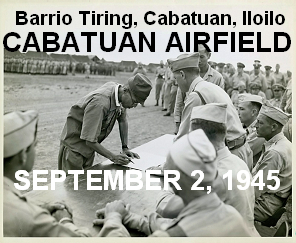
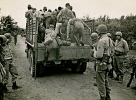

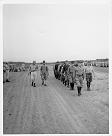


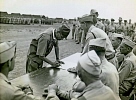
Col. Ryoichi Tozuka signs the surrender instrument
as Col. Raymond G. Stanton looks on.
Cabatuan Airfield
Barrio Tiring, Cabatuan, Iloilo
Panay Island, Philippines, September 2, 1945
|
|
- o -
|
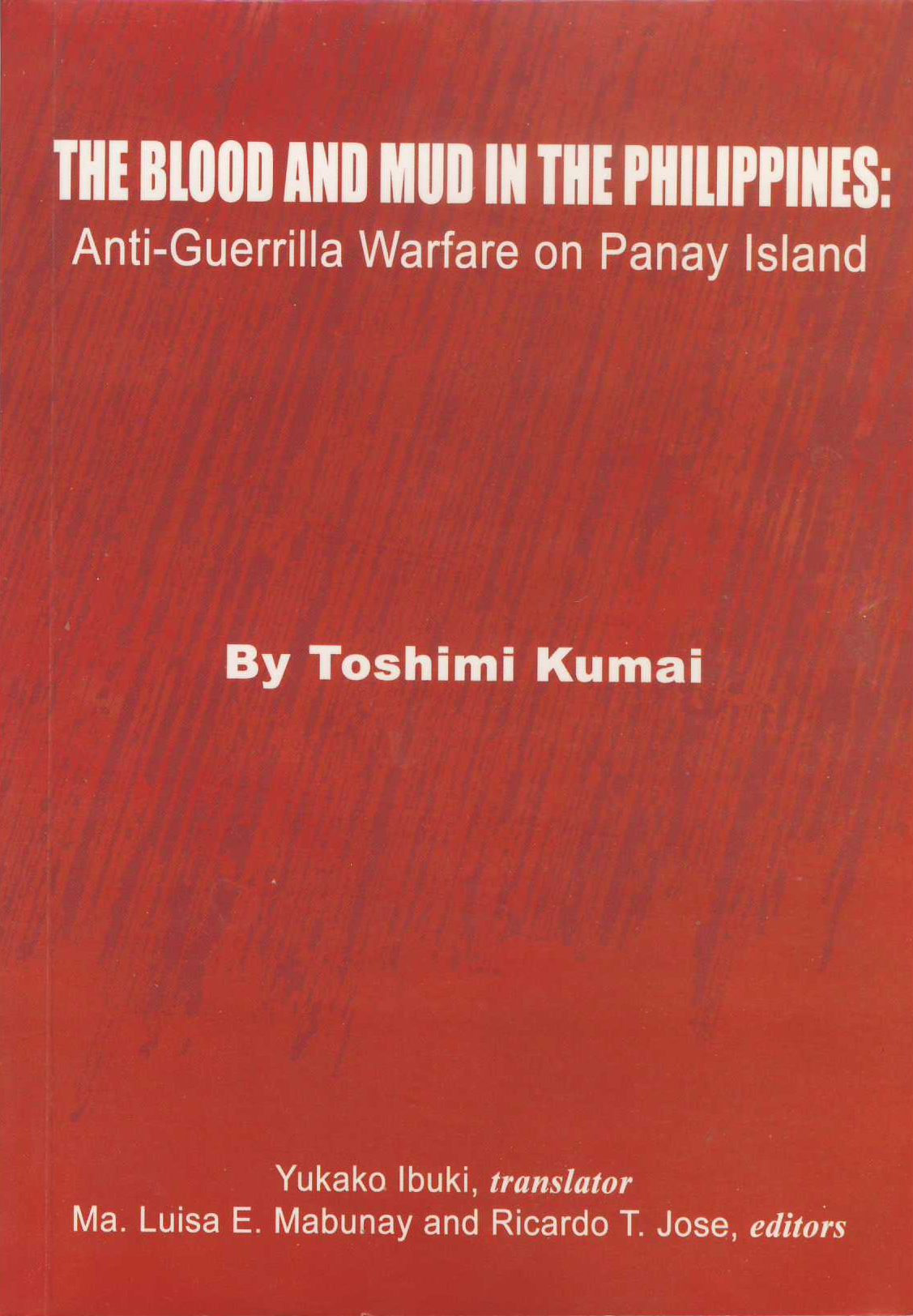
The Blood and Mud in the Philippines
Anti-Guerrilla Warfare on Panay Island
by Toshimi Kumai
Yukako Ibuki, translator
Ma. Luisa E. Mabunay and Ricardo T. Jose, editors
|
|
Chapter 11 – War Criminals
11.1 War Criminal Kamikaze Unit
Amidst the bright lights of around 300 ships that surrounded us, our transport reached near the shores of Tacloban on the island of Leyte late at night. Towards the morning, landing craft brought us into the coconut groves at the Palo shore. We were loaded into waiting trucks that brought us to the Palo POW camp six or seven kilometers away. Henceforth, we were imprisoned separately within a vast campsite. Officers (shôko) went into the officer’s camp while NCOs and soldiers (heishi) were sent to labor camps. Even now, most of the soldiers had been out of touch with each other. In was under these circumstances that the Japanese Army of Panay was actually dissolved.
We learned that near Camp Palo, a regiment of the 16th Division of the Japanese Army had been annihilated and that the regimental flag was burned in the mountain behind it when the US Forces had landed. It was probably because of this that there were rumors about Japanese soldiers’ ghosts sometimes appearing in the camp. There was no work for officers and the boring life as POWs started. To kill the time, sumo tournaments, volleyball and basketball games, and variety shows were held. Meanwhile, group after group of POWs from the Visayas and Mindanao areas kept on arriving.
One day towards the end of November, nine people were summoned: staff officer Colonel Hidemi Watanabe, unit commander Colonel Tozuka, Captain Makoto Yoshioka, 1st Lieutenant Hajime Fujii, Captain Jiro Motoki, Second Lieutenant Otsuka, and myself from the Japanese Army; also Captain Kaneyuki Koike and WO Fusataro Shin of the Kempeitai. Seeing the line up of the nine, I felt a chill in my heart. Immediately we were moved to another section of the camp, and were squashed in a narrow section surrounded by double fences. Already imprisoned there were Sergeant Sugimoto and six others from the Onishi unit of Cebu Island, and Major Mikami and eight others of the 30th Division (commonly called the Panther Division) of Mindanao Island. When we were put in two tents for twenty, I felt as if my body had been kicked into a bottomless pit. It was absolute desperation. The dream of returning home to Japan became an illusion. The troubles and worries I had experienced during more than three years in Panay came back to haunt me all at once.
Next morning, while it was still dark, I was awakened by the noise from the guard who was pounding empty tin cans. Breakfast was one cup of thin corn soup. The amount of food in the meals suddenly decreased. Because of hunger, I could hardly move around. Eventually, more people arrived at the camp, including Sergeant Tokizo Makita, Corporal Itai, Private First Class Sekitomo Ueki, Master Sergeant Shirakura, Master Sergeant Yoshiaki Sumitani, Sergeant Watanabe, Interpreter Ogino were from the Kempeitai. Several days later, we were joined by 1st Lieutenant Toyota.
Eventually the Special Camp became full of war criminal suspects from different places, and the number of tents increased. Day after day, with three meals of just a cup of corn soup and water, I was hungry. When I stood up, I felt dizzy. This was the first experience of hunger I ever had in my life. Beyond the double fences, it seemed there was the camp of Hôjin women and children, and I sometimes heard the distinctive accent of the Taiwanese comfort women. The hunger became unbearable. Thus, I went up to the fence one evening, and wishing with a big ‘IF’, I called to one of the women speaking in Taiwanese accent. She happened to be one of the comfort women who had been in Panay Island. On hearing that officers from Panay were imprisoned in the War Criminal Suspects’ Camp, she was shocked and became very sympathetic. She promised to bring me food.
Next morning, I heard a sound like that of coconuts dropping–‘boton, boton’ – and got out of the tent. There were tins scattered around. They were ration tins of the US forces. We jumped at them with cries of joy and, after the spell of hunger, ate to our satisfaction. Eventually the Hôjin women from Iloilo joined in the throwing in of foodstuffs. The guards generously ignored that. Those gifts from the women’s camp were shared with POWs from other units and were appreciated.
One thing that made the women from Panay exert much effort to give us gifts of food was their appreciation of the unit commander, Colonel Tozuka, and other officers. In the mountains of Bocari, they seemed to have been quite discontented by their treatment by the army. Yet at the camp in Leyte, the women from other islands were tearfully envious of them since they had their children with them. When going into the mountains in other islands, children under twelve were killed by soldiers since they were deemed hindrances to operations of the Japanese Army. The Taiwanese comfort women had compassion for us because they had discovered that it was only in Panay that all the Taiwanese comfort women survived.
In December, the soldiers who were returning to Japan from Leyte increased in number. Seeing them depart with filled bags and full of joy, those of us left behind felt even more depressed. WO Shin of the Kempeitai had become involved with a pseudo-religion, and it was a pitiful sight to see him praying so eagerly.
On February 2, 1946, the 50 of us who were suspects were sent to Manila from Tacloban harbor in a small transport. We arrived in Manila after a few days, and were sent by car to Calamba Camp in Laguna Province near Lake Laguna, 50 kilometers south of Manila. When we entered the camp, Colonel Shoichi Yamaguchi – commander of the 172nd Battalion of Negros Island who had been there some time before us – came over and told us about the situation of the war crimes trials with a serious expression on his face. He informed us that General Yamashita had already been sentenced to death. Furthermore, according to the trials held so far, those who had killed even just one Filipino, for whatever reason, received the death penalty while those who inflicted torture got imprisonment for life. One out of two suspects received the death penalty.
Next morning as I got out of bed, I saw pale suspects in rags appear one after another from each tent. They were officers who fought in Luzon and the sight made me imagine the fierceness of the warfare there. About 400 or 500 meters beyond the camp fence were hundreds of white crosses that marked graves. Behind them was the dark Mt. Makiling that looked down on the vast camp area. This was where the 8th Division had desperately fought, causing a great number of victims.
On March 3, we were moved to a camp at Nichols Field in the suburbs of Manila, currently the Manila International Airport. Here all 14 of us – starting with Lieutenant General Kôno, staff officer Colonel Hidemi Watanabe, unit commander Lieutenant Colonel Tozuka and other suspects related to Panay – were assembled. As we were summoned for examination one by one everyday, the full picture of the incidents under suspicion revealed itself. Most of the incidents were cases that happened during the half-year Joint Punitive Operation from July to December of 1943. The number of Filipino deaths was 2,000 and there were 14 of us. I thought it was impossible to survive in such a situation.
One night, General Kôno assembled the others, and he said with emotion, ‘I’m an old man and I do not have a long future to look forward to. I want to save your lives if possible. Tell me if you have any wish.’ The General had never talked to us frankly. When he started to speak to us like this, we could not utter any of the complaints we might have had. After all, it was decided that General Kôno and unit commander Tozuka would take responsibility for the whole situation of Panay, and that each of us would take responsibility for specific cases. At the end of the day, General Kôno said, ‘Lieutenant General Akira Mutô, the Chief of Staff of the Philippine Islands Area Army who stood as a witness at General Yamashita’s trial, is now in this camp; so let us listen to him as well regarding the trials.’
Several days later, the suspects related to Panay Island got together at General Mutô’s tent where he spoke with great spiritual potency. ‘The war has not ended in the real sense of the word. The US is trying to kill as many Japanese officers and soldiers as possible. In war, the important thing is to cause as few Japanese victims as possible. In the trials as well, what we should do is not to name any others. You are all honorable kamikaze fighters. You should fight the trial with the spirit of a kamikaze. In addition, the US Forces want to say that the top commanders of the Japanese Army had ordered the killing of non-combatants. You should never say, for the sake of Japan, for the sake of the Japanese Army, that anyone who graduated from the Imperial Military Academy had ever ordered killing of non-combatants.’
The solemn talk of the Chief of Staff of the 14th Area Army whom we met for the first time impressed us. However, the countermeasure policy, i.e., the ‘War Criminal Kamikaze Unit’ suggested by General Mutô, seriously affected the proceedings of the war crimes tribunals in the Philippines. The high-ranking officers meticulously followed this policy – unanimously repeating ‘I have nothing to do with the case. I know nothing about it .’
On top of this, the trials that I later observed did not necessarily proceed according to what the Chief of Staff, General Mutô, told us. Some US soldiers did understand bushi no nasake, the benevolence of the samurai. There were the cases related to the Batanes Islands, the small islands scattered between Northern Luzon and Taiwan. Lieutenant General Hikojiro Tajima, commander of the 6lst Independent Mixed Brigade and his 13 subordinates were tried for the execution of three US pilots who were shot down and became POWs. They were also charged with the execution of the guerrillas who had killed 13 guards of the Japanese Army. In order to save his subordinates, General Tajima testified that he had ordered the killings. Therefore, only General Tajima was sentenced to death by hanging and was executed in April 1946. I heard that the Presiding Judge of that trial was so moved by General Tajima’s affectionate attitude toward his subordinates and grew to respect him.
In time, investigators came with around 50 Filipinos to identify us suspects from Panay. General Kono and the others were all kept standing under the scorching sun in the square. The citizens of Panay, guided by Philippine Army officers, tried hard to remember our faces, checking us out with the photographs in their hands. As they came in front of me, an investigator said, ‘This is Kumai’, with a thin smile on his face. I understood that to have meant his reminder for other Filipinos to remember my face. I got so exhausted after one hour of standing under the burning sun and collapsed into bed as soon as it was over. After the identification process was over, it seemed more certain that we would be condemned as war criminals. They were saying that it would be the death penalty for one killing, and the number we had killed was supposedly 2,000.
Dividing the blame among the 14 left no possibility for us to survive. I spent the next few days in a desperate mood as if my death sentence had already been confirmed. At the end of the day, I looked blankly upon the mountains east of the camp. The inviting peaks of Antipolo showed themselves clearly in front of me in the rays of the setting sun. I made a sudden decision to escape.
As I looked back, we surrendered obeying the emperor’s order. Had I known that I would face the cruel fate of the death penalty, I would not have surrendered but fought on until my last breath. I regretted to having surrendered following the order, without an inkling that the situation would turn out this way. Now that I was abandoned even by my country, Japan, to which I dedicated my life. I decided I had to fight for my own sake.
I called on 2nd Lieutenant Ôtsuka thinking as the old proverb says, ‘It is good to have a partner on one’s journey’. Grinning, he said, ‘I’ve been waiting for your call, Kumai-san,’ and he pointed under his bed. There he had accumulated salt and a fair amount of pills for malaria.
One night while we were trying to determine the timing of our escape, the former 14th Army Chief of Staff Lieutenant General Takaji Wachi was brought to our prison camp. He had been summoned from Japan as a witness for Lieutenant General Masaharu Homma, former commander of 14th Area Army, who was being tried for the Bataan Death March. We decided to listen to his talk about the situation of Japan. Members of the camp got together at his tent and we listened to him late into the night. His talk not only impressed us but also made us angry. As I paid attention to the stories about Japan that I wanted to know, I considered that it was the right time to escape.
On that same night, however, three POWs had run away – namely, Master Sergeant Kuwano, Sergeant Makita and Corporal Itai – and there was great confusion throughout the camp. Hurriedly, the authorities started to build a double barbed-wire fence that was nearly three meters tall around the War Criminal Suspects’ Camp. Those POWs got a head start on me and I felt very sorry to be left behind. All the same, there was nothing I could do but pray for their success. Four or five days passed, and I was happily thinking that they must have succeeded. Then suddenly, a cage-like structure measuring about five meters square was built at the camp entrance. To our surprise, the three who had attempted to escape were put in that cage. We later learned that Itai had lost his shoes while the three were swimming across the 100-meter wide Pasig River. He soon was unable to walk on land, and they had hidden themselves in a swamp for three or four days. They gave up when they got hungry and surrendered to nearby residents.
Several days after the incident, the thick barbed-wire fence around the camp was completed and the number of guards increased.
|
|